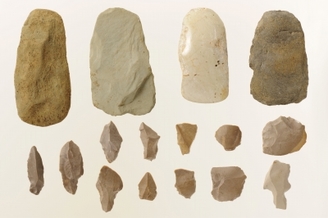The Jizouden Site -the Paleolithic Culture- Report of Excavation ,1985
Outline of the Jizouden Site -the Paleolithic Culture-

The Jizouden Site is located in the southern suburb of Akita City, Akita Prefecture. It is situated on the lower river terrace (L1) of the right bank from the Iwami River in Akita Plains where is at a height of 31m above sea level. The site was discovered by the Akita City Board of Education in 1985.
A total of 4,447 paleolithic artifacts were discovered from the Jizouden Site. 4,358 artifacts in the Late Paleolithic Period which exhibited 14 concentrated areas were recorded.
The stratigraphy at the site is as follows:
Stratum 1: modern cultivated layer
Stratum 2: Jomon and Yayoi Period layer
Stratum 3: transitional layer
Stratum 4a: yellowish brown clayey silt
Stratum 4b: yellowish brown and brown clayey silt
Stratum 4c: bright yellowish brown clayey silt
Stratum 5: dull yellowish brown clayey silt
Stratum 6: light gray clayey silt
Stratum 7: light gray clayey silt
Stratum 8: bright yellowish brown clayey silt
Stratum 9: light gray sandy silt
Stratum 10~15: terrace gravel layer
Paleolithic artifacts in stratum 4a and 4b are inferred in situ.
The assemblage consists of axes (N=4), knife shaped tools (N=5), pen-point-knife shaped tools (N=22), trapezoid tools (N=39), side-scrapers (N=8), end-scrapers (N=4), notches (N=5), denticulates (N=7), retouched-flakes (N=18), cores (N=71), pebble tools (N=9), flakes (N=1,555), and chips (N=2,700). The total number is 4,447(Table.2.). Most of lithic artifacts were made of hard siliceous shale, but axes and pebble tools were made of serpentinite, hornfels, granite, and so on.
We consider that these lithic artifacts were belonged to the first half of the Upper Paleolithic Period.
Resulting AMS 14C determinations of carbonized remains excavated from concentrated areas of BL3, BL4 and BL7 are below;
Sample:C-1【IAAA-103442】(excavated from Block3)
-
C14yrBP
-
29,720±130yrBP
-
calBC(1σ)
-
32,773~32,501calBC(61.0%)
32,328~32,244calBC(7.2%) -
calBP(1σ)
-
34,722~34,450calBP(61.0%)
34,277~34,193calBP(7.2%) -
calBC(2σ)
-
32,827~32,029calBC(95.4%)
-
calBP(2σ)
-
34,776~33,978calBP(95.4%)

Sample:C-65【IAAA-103443】(excavated from Block4)
-
C14yrBP
-
30,110±140yrBP
-
calBC(1σ)
-
32,910~32,677calBC(68.2%)
-
calBP(1σ)
-
34,859~34,626calBP(68.2%)
-
calBC(2σ)
-
33,072~32,596calBC(95.4%)
-
calBP(2σ)
-
35,021~34,545calBP(95.4%)

Sample:C-25【IAAA-103243】(excavated from Block7)
-
C14yrBP
-
28,080±120yrBP
-
calBC(1σ)
-
30,662~30,001calBC(68.2%)
-
calBP(1σ)
-
32,611~31,950calBP(68.2%)
-
calBC(2σ)
-
30,910~29,736calBC(95.4%)
-
calBP(2σ)
-
32,859~31,685calBP(95.4%)


Note:
Calibration program are Intcal09 and OxCalv4.1
presented by Institute of Accelerator Analysis Ltd.
1,545 lithic artifacts (34.7% of all lithic artifacts) were grouped to 35 nodules and 694 lithic artifacts are refitted. We consider that some row materials of lithic artifacts were gotten around the Jizouden Site.
Stone flaking technique is classified into four types. Main flaking techniques were 2.~4.types which produced 1 : 1 (ratio length: width) flakes. Most of blank flakes of tools were made by these techniques. Blade technique was not performed at the Jizouden Site.
Lithic distribution at the Jizouden Site was composed of 14 lithic concentrated units. It is said that the pattern is considered to be "circular shaped lithic distributions". "Circular shaped lithic distributions" is a characterized feature at the early Upper Paleolithic Period in Japan, and the Jizouden Site is one of the typical examples. The diameter of circular shaped lithic distributions at the Jizouden Site is about 30m. Carbonized remains and heated lithic artifacts concentrated on BL3, 4, and 7. Knife shaped tools, pen-point-knife shaped tools, and trapezoid tools concentrated on BL4 where was in the center part of the circular shaped lithic distribution. By contrast, Axes and Pebble tools were scattered around part of the circular shaped lithic distribution.
According to the result of lithic use-wear analysis Dr. Yoshitaka Kanomata, Associate Professor of Tohoku University, knife shaped tools, pen-point-knife shaped tools, and trapezoid tools which have blunting on base have impact fractures. These stone tools which consequently concentrated on BL4 where was in the center part of the circular shaped lithic distributions were probably used to thrust something. Also the axe was probably used to scrape hide. By the reasons of lithic use-wear analysis and stone tools distribution, Dr. Kanomata considers that why the circular shaped lithic distributions had been formed in the Jizouden Site was to hunt large animal at that period of time.
Paleolithic artifact of the Jizouden Site is one of the representative industry of the first half of the Upper Paleolithic Period in Japan, therefore, this site is considered to be very important to study Paleolithic Period.
Attribute of all lithic artifacts
Report(PDF)
Second edition PDF(refrected eratta)
-
All Capter(2ed) (PDF 31.0MB)

Size A4, 234p
(divided version)
-
Cover-Chapter3_2 (2ed) (PDF 3.8MB)

-
Chapter3_3 (2ed) (PDF 12.0MB)

-
Chapter3_4 (2ed) (PDF 4.6MB)

-
Chapter4 (2ed) (PDF 742.5KB)

-
Appendix1 (2ed) (PDF 827.5KB)

-
Appendix2 (2ed) (PDF 718.4KB)

-
Appendix3 (2ed) (PDF 810.9KB)

-
Summary (2ed) (PDF 535.9KB)

-
Plate_color (2ed) (PDF 7.6MB)

-
Plate_monochrome-back_cover (2ed) (PDF 4.1MB)

Cf: First edition PDF
Photo
-

Goshono terrace.
-

Situation of Excavation.
-

Lithic artifacts execavated from the Jizouden Site 1.
-

Lithic artifacts execavated from the Jizouden Site 2.
PDFファイルをご覧いただくには、「Adobe(R) Reader(R)」が必要です。お持ちでない方はアドビシステムズ社のサイト(新しいウィンドウ)からダウンロード(無料)してください。
よりよいウェブサイトにするために、ページのご感想をお聞かせください。
このページに関するお問い合わせ
秋田市観光文化スポーツ部 文化振興課
〒010-8560 秋田市山王一丁目1番1号 本庁舎3階
電話:018-888-5607 ファクス:018-888-5608
お問い合わせは専用フォームをご利用ください。
